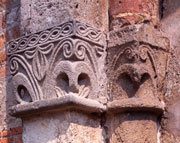
Pieve of San Martino
History
 The Pieve at Palazzo Pignano is almost 1000 years old, and over the years has been damaged, changed, renovated, decorated and restored numerous times. If you look from the outside, you can see the various changes made to the original walls where the bricks are laid out in a fish bone pattern. You can also see a sculptured relief that was reused above the entrance arch to the left.
The Pieve at Palazzo Pignano is almost 1000 years old, and over the years has been damaged, changed, renovated, decorated and restored numerous times. If you look from the outside, you can see the various changes made to the original walls where the bricks are laid out in a fish bone pattern. You can also see a sculptured relief that was reused above the entrance arch to the left.
The parish Church of Palazzo Pignano is dedicated to Saint Martino, and was built at the end of the XI century (in about 1090). Documents dating to the year 1000 indicate that 100 years earlier another older Church called a "Pieve", already existed on the site. The parish of the Pieve in Palazzo Pignano included several surrounding villages. The Pieve in Palazzo Pignano was also called a "collegiate" because it housed at least fifteen priests who lived and prayed there together. Before the year 1000, the Pieve in Palazzo Pignano and its parish fell under the Diocese of Piacenza.
Palazzo Pignano was a very important centre during the entire Middle Ages. It was only in 1450 that Crema was declared a city of the Venetian Republic and the Parish at Palazzo Pignano, which was also the vicarage of the Bishop of Piacenza, asked to be transferred with its priests to the city of Crema. Palazzo Pignano therefore diminished in importance and in 1580 finally broke away from the Diocese of Piacenza, to become part of the new Diocese of Crema.
Today, the Pieve at Palazzo Pignano is still considered as the mother Church in the Crema Diocese. Any new Bishop, before formally taking over the diocese, will in fact come and visit this ancient Church in recognition of the significant events and origins that have marked its history.










